
[Looney
Labs] [Shopping
Center]
 
News Archives
-

- [Guide] [Games] [E-Books]
[WTS]

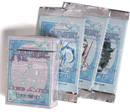


The Aristocrats :)
Here's a nice haiku,
filled to the brim with feces!
Guess what I call it?
 
Atomic
Bomb Paintings

"Fluxx involves a variety of school-appropriate activities
and skills. Like any good game, especially one with elements
of strategy and abstraction, Fluxx is a good exercise for mental
agility. Like chess, it promotes prediction with limited information
and problem solving with limited resources. By the nature of
its play, Fluxx involves all of the following skill areas: Kinesthetic
learning, Number sense, Problem-solving, Reading comprehension,
and Social skills. Fluxx, like any well-designed game, offers
many real opportunities for learning. Bounce off some teachers
and parents the factors just listed and see if they don't find
new uses for Fluxx and other games in their classrooms and homes."
-- David Millians, "Working in Fluxx,"
Comics & Games Retailer, June 2005, pages 22-23
   
|

|
|
 |
Looney Labs is Featured in
Games Magazine! |
|
|
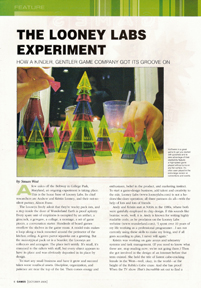 A
couple of months ago, a woman named Susan West came into town
to visit us at our office and interview us for an article she
was working on for Games
Magazine. It was to be an article all about us and our company,
Looney Labs. Well, the article she wrote appears in the October
issue, and it's huge! It's like the main feature! It's a full
6 pages long, with 10 full-color images! Wow! A
couple of months ago, a woman named Susan West came into town
to visit us at our office and interview us for an article she
was working on for Games
Magazine. It was to be an article all about us and our company,
Looney Labs. Well, the article she wrote appears in the October
issue, and it's huge! It's like the main feature! It's a full
6 pages long, with 10 full-color images! Wow!
Shown here are thumbnails of the 6-page article, but since
I don't have permission to reproduce the whole article here yet,
you'll have to track down an actual copy of the magazine to read
it for itself. (UPDATE: Here is the article!) And I don't know how soon it will be on the newsstands;
being subscribers, our copy was immediately mailed directly to
us. (A quick check of a local newsstand revealed it wasn't there
yet.)
Press coverage is never perfect, and this article is no exception.
There are a several little mistakes and inaccuracies in the Games
article... for example, she makes it sound like Alison arrived
in our lives at the same time as Fluxx, when in fact those events
were years apart. And I couldn't help but chuckle at the typo
that turns the Cheapass Games corporate demo-team from Demo Monkeys
into Demon Monkeys. But on the whole, it's a very good article,
which does a good job of explaining us and our dreams.
|
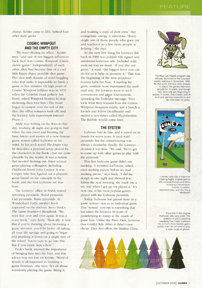
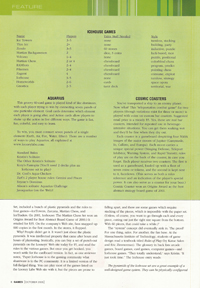
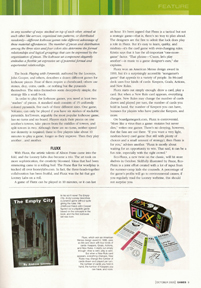
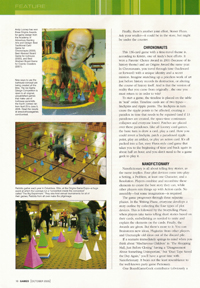 |
|
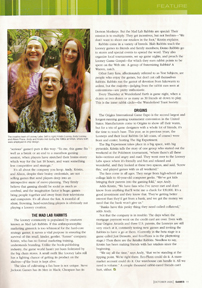 As
if that weren't cool enough, this week we also discovered a wonderful
two-page article on Fluxx, which appeared in the June issue of
Comics & Games Retailer magazine. It's called "Working
in Fluxx," and it was written by noted "Games and Education"
expert David Millians. The article is aimed at teachers, suggesting
ways to feature Fluxx -- and the lessons in can teach -- in the
classroom. The article even includes a Lesson Plan for Fluxx!
And unlike the long-anticipated article in Games magazine (and
the forthcoming blurb about EcoFluxx in Backpacker magazine),
this Comics & Games Retailer article was a total surprise
to us: It just showed up! Wow! As
if that weren't cool enough, this week we also discovered a wonderful
two-page article on Fluxx, which appeared in the June issue of
Comics & Games Retailer magazine. It's called "Working
in Fluxx," and it was written by noted "Games and Education"
expert David Millians. The article is aimed at teachers, suggesting
ways to feature Fluxx -- and the lessons in can teach -- in the
classroom. The article even includes a Lesson Plan for Fluxx!
And unlike the long-anticipated article in Games magazine (and
the forthcoming blurb about EcoFluxx in Backpacker magazine),
this Comics & Games Retailer article was a total surprise
to us: It just showed up! Wow!
Thanks for playing our games and reading our webzine, and
have a great week!
 |
|

 |
"Every spare unit of emptiness is occupied by an artifact,
a gimcrack, a gewgaw, a collage, a montage, a set of game pieces,
a conversation starter. Hundreds of board games overflow the
shelves in the game room. A model train makes a loop along a
track mounted around the perimeter of the kitchen ceiling. A
green parrot squawks out a greeting. But the stereotypical pack
rat is a hoarder; the Looneys are collectors and arrangers. The
place isn't untidy. It's small, it's crammed to the rafters with
stuff, but every object appears to have its place and was obviously
deposited in its place by design." -- Susan
West, "The Looney Labs Experiment,"
Games Magazine October 2005, page 6 |
 |
"Brother Frank has once more gone to Iraq. Bleh. This
war is really depressing. For lots of people I'm sure it's just
a minor annoyance, perhaps for some people it's a rush, but for
some of us who opposed this war at the start--and some of us
with friends and family over there right now--it's a huge, dark,
open chasm. My brother Frank is wonderful, and I love him dearly.
He chose his job and he is very good at it, and I wished him
well when I hugged him goodbye. Now he's at the chasm's edge
again. Bleh. I used to climb cliffs and ride motorcycles a lot.
Hell, I even smoked cigarettes. I chose to do those activities
and I understood the risks; life is like that, you choose your
potions. The Iraq war is different potion: Concocted by a very
small group of hack chefs out of the leftovers from an oily family
feud gone awry, and force-fed to millions. Now they've spilled
it all over the place and we're depending on nice people like
my brother to clean it up." -- John Cooper,
GinohnNews,
August 17, 2005 |
 |
"Future archaeologists trying to understand what the
Shuttle was for are going to have a mess on their hands. Why
was such a powerful rocket used only to reach very low orbits,
where air resistance and debris would limit the useful lifetime
of a satellite to a few years? Why was there both a big cargo
bay and a big crew compartment? What kind of missions would require
people to assist in deploying a large payload? Why was the Shuttle
intentionally crippled so that it could not land on autopilot?
Why go through all the trouble to give the Shuttle large wings
if it has no jet engines and the glide characteristics of a brick?
Why build such complex, adjustable main engines and then rely
on the equivalent of two giant firecrackers to provide most of
the takeoff thrust? Why use a glass thermal protection system,
rather than a low-tech ablative shield? And having chosen such
a fragile method of heat protection, why on earth mount the orbiter
on the side of the rocket, where things will fall on it during
launch? Taken on its own merits, the Shuttle gives the impression
of a vehicle designed to be launched repeatedly to near-Earth
orbit, tended by five to seven passengers with little concern
for their personal safety, and requiring extravagant care and
preparation before each flight, with an almost fetishistic emphasis
on reuse. Clearly this primitive space plane must have been a
sacred artifact, used in religious rituals to deliver sacrifice
to a sky god." -- Maciej Ceglowski, "A
Rocket To Nowhere" |
|
 |
|